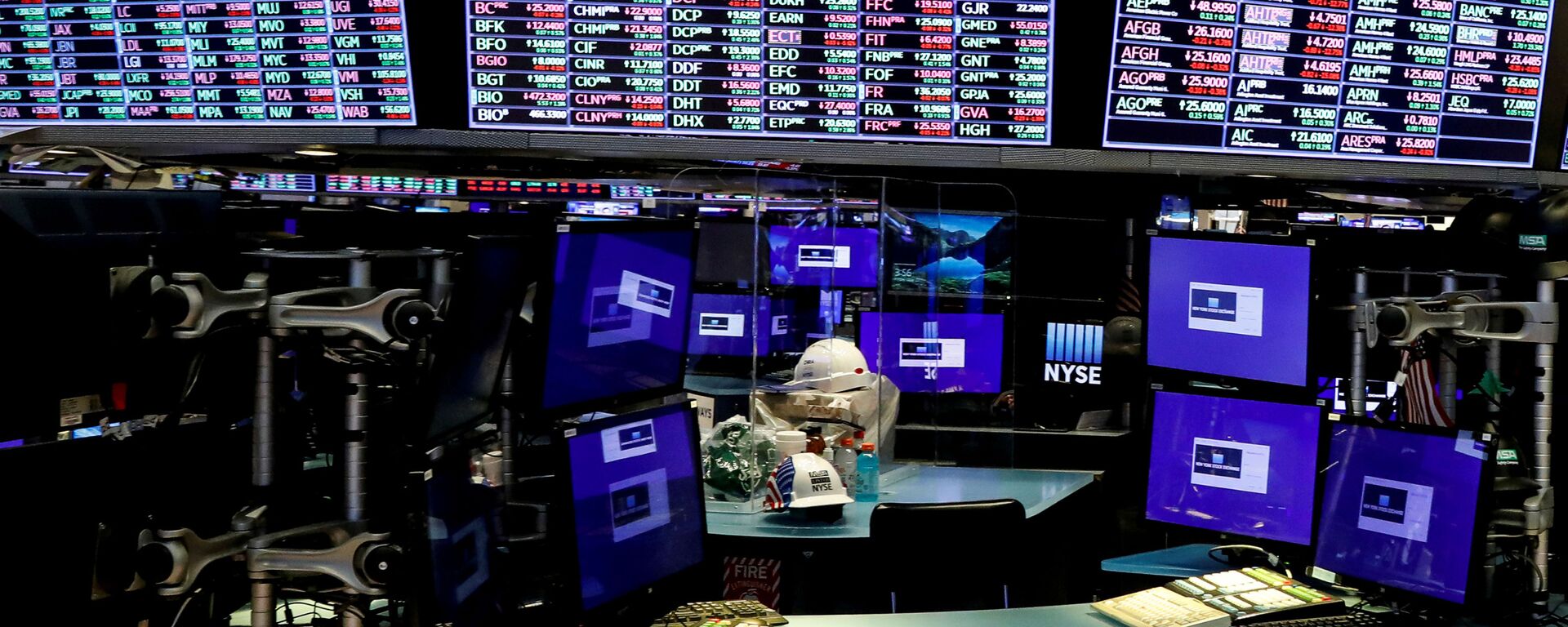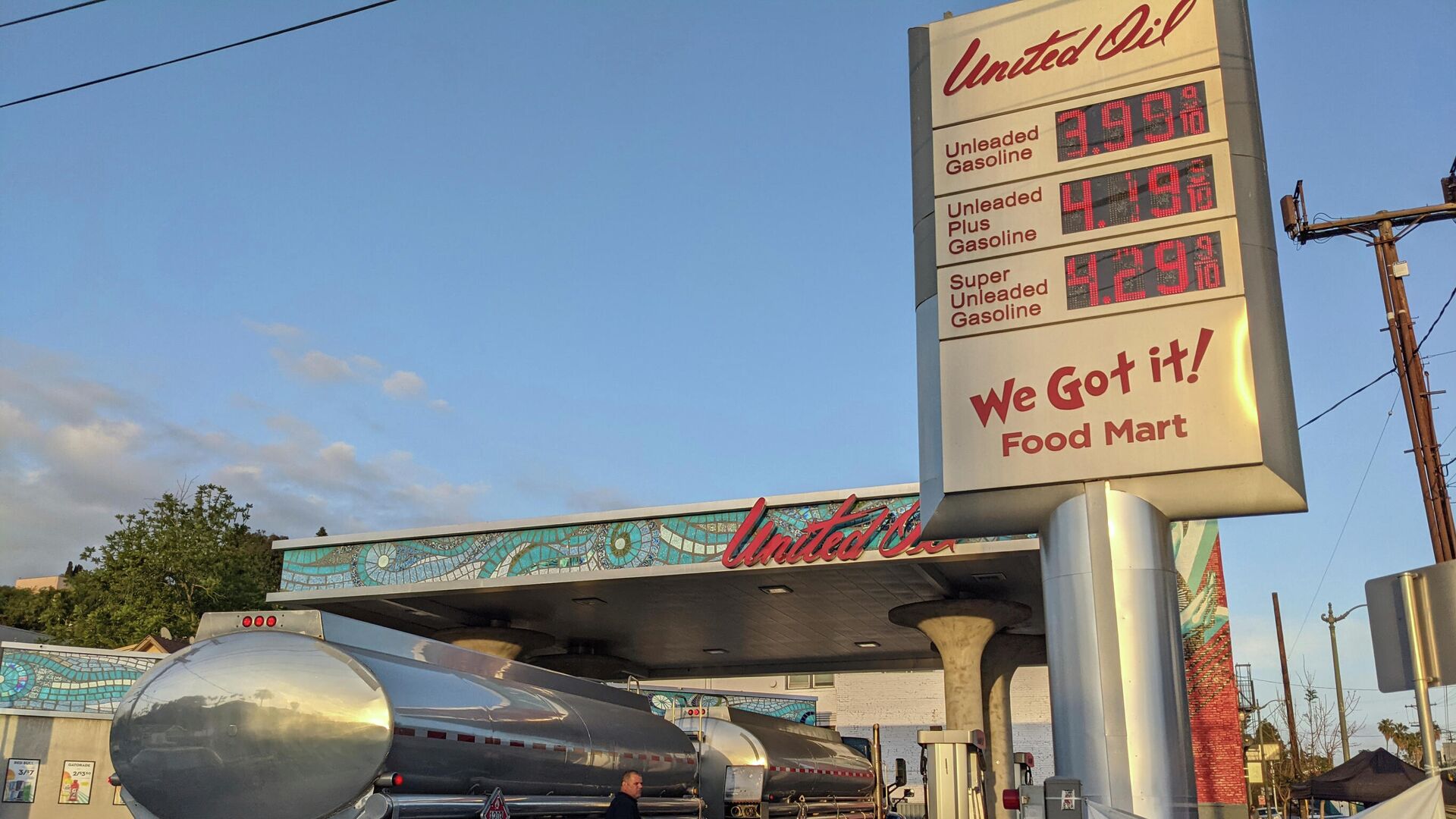https://sputnikglobe.com/20211012/high-energy-prices-can-speed-up-inflation-ultimately-slow-economic-recovery-in-us---report-1089847491.html
High Energy Prices Can Speed Up Inflation, Ultimately Slow Economic Recovery in US - Report
High Energy Prices Can Speed Up Inflation, Ultimately Slow Economic Recovery in US - Report
Sputnik International
The rise in energy prices continues all over the world amid the continuing energy crisis. Crude oil has increased by more than 64% this year, reaching a... 12.10.2021, Sputnik International
2021-10-12T00:30+0000
2021-10-12T00:30+0000
2024-06-08T13:07+0000
us
gop
gas supplies
fuel price
economy
fuel
https://cdn1.img.sputnikglobe.com/img/07e5/0a/0c/1089848412_0:0:2733:1538_1920x0_80_0_0_cdea19006121252ab400a98f587e631a.jpg
Energy prices might drive up inflation in the coming months, stifle consumer spending on other goods and services, and impede the US economy's recovery in general, The Wall Street Journal reported, citing analysts.Explaining the effect of the price increase, economist Kathy Bostjancic of Oxford Economics, quoted in the report, described it as a "tax" on consumers. While consumers will undoubtedly be pinched, she said that an increase in energy prices "would have to be extreme and prolonged" to derail the economic recovery. Quite possibly, "we would just see growth decelerate more or a longer pause before growth resumes, and that we just get a bit stickier inflation in the meantime."However, Andreas Steno Larsen, an analyst at Nordea Bank ABP in Helsinki, is much more pessimistic. He said the surge in energy prices this year has caused him to lower his GDP forecast for US economic growth next year to 1.5% from his original of 3.5%. While he reportedly expects oil and gas prices to remain stable in the next months, he also anticipates a worst-case scenario in which they climb by another 40% next year, causing the US and global economies to enter a brief recession in mid-2022.Experts noted that natural gas assets are running low after a freeze in Texas earlier this year drove up demand and Hurricane Ida shut down nearly all of the Gulf of Mexico's gas production, as well as due to increased demand from Europe, where inventories have dropped due to hot weather, lackluster wind power generation, and lower imports from Russia, as well as higher demand from Asia.Rising demand has collided with supply constraints imposed by carbon emission reduction policies, driving up coal prices.Moreover, many analysts predict that these factors will continue to drive prices higher in the coming months. According to the report, oil prices are expected to rise to between $80 and $90 per barrel by early next year, and natural gas prices to $6.50 to $7 per million British thermal units, up from $5.5650 now, according to Moody's Analytics. At the same time, according to JPMorgan Chase & Co., oil will rise over the next three years, hitting $190 a barrel in 2025. Electricity costs in the US increased 5.2% in August from a year ago, the highest increase since early 2014, the nation's Labor Department outlined.Rising Inflation Rate and Dwindling Cushion of SavingsExperts stress that in Europe and Asia, where shortages are most serious, higher prices have already sparked fears of an economic collapse. For a variety of factors, analysts believe the impact will be less severe in the US. Natural gas prices have risen far less because the United States is a major producer and much of its supply remains within the country. Moreover, gas inventories are not as low as they are for oil.According to Kevin Book, managing director of ClearView Energy Partners LLC, a research organization, the impact of increased energy prices on consumers' utility bills will differ across the country. Depending on how rates are structured, some utility companies may begin to adjust bills this winter, while others may not raise prices until later.However, higher oil prices, according to economists, might raise the annual inflation rate by 0.4 percent in the coming months.According to the Commerce Department's price index for personal consumption expenditures, consumer prices jumped 4.3% in August from a year ago. The Federal Reserve has set a target of 2% annual inflation. And energy prices, according to Oxford Economics, will help lift the annual inflation rate to 5.1% by the end of the year.High oil and gas prices benefited the US economy in the early and mid-2010s, encouraging oil and gas companies to exploit abundant shale reserves and driving up demand for steel, equipment, construction workers, truck drivers, and other labor.While energy prices are volatile even in non-pandemic times, they are even more so now, given the uncertainty regarding the economic future and how governments and investors may react to supply constraints. Investors are forcing firms to maintain high pricing and profit margins by refusing to drastically expand output.High energy prices have frequently signaled the start of recessions. Higher costs function as a tax, draining the money available to spend on other products and services because consumers can't immediately curtail consumption on short notice, as they can with discretionary purchases.
https://sputnikglobe.com/20210928/us-tech-stocks-down-most-since-march-as-inflation-rate-hike-worry-roil-wall-street-1089496628.html
Sputnik International
feedback@sputniknews.com
+74956456601
MIA „Rossiya Segodnya“
2021
News
en_EN
Sputnik International
feedback@sputniknews.com
+74956456601
MIA „Rossiya Segodnya“
Sputnik International
feedback@sputniknews.com
+74956456601
MIA „Rossiya Segodnya“
us, gop, gas supplies, fuel price, fuel
us, gop, gas supplies, fuel price, fuel
High Energy Prices Can Speed Up Inflation, Ultimately Slow Economic Recovery in US - Report
00:30 GMT 12.10.2021 (Updated: 13:07 GMT 08.06.2024) Kirill Kurevlev
Managing Editor
The rise in energy prices continues all over the world amid the continuing energy crisis. Crude oil has increased by more than 64% this year, reaching a seven-year high of $82 a barrel on Monday. Natural gas prices have also risen to a seven-year high in the last six months, while coal prices are at all-time highs.
Energy prices might drive up inflation in the coming months, stifle consumer spending on other goods and services, and impede the US economy's recovery in general, The Wall Street Journal
reported, citing analysts.
Explaining the effect of the price increase, economist Kathy Bostjancic of Oxford Economics, quoted in the report, described it as a "tax" on consumers.
While consumers will undoubtedly be pinched, she said that an
increase in energy prices "would have to be extreme and prolonged" to derail the economic recovery. Quite possibly, "we would just see growth decelerate more or a longer pause before growth resumes, and that we just get a bit stickier inflation in the meantime."
However, Andreas Steno Larsen, an analyst at Nordea Bank ABP in Helsinki, is much more pessimistic. He said the surge in energy prices this year has caused him to lower his GDP forecast for US economic growth next year to 1.5% from his original of 3.5%.
While he reportedly expects oil and gas prices to remain stable in the next months, he also anticipates a worst-case scenario in which they climb by another 40% next year, causing the US and global economies to enter a brief recession in mid-2022.
Experts noted that natural gas assets are running
low after a freeze in Texas earlier this year drove up demand and Hurricane Ida
shut down nearly all of the Gulf of Mexico's gas production, as well as due to increased demand from Europe, where inventories have dropped due to hot weather, lackluster wind power generation, and lower imports from Russia, as well as higher demand from Asia.
Rising demand has collided with supply constraints imposed by carbon emission reduction policies, driving up coal prices.
Moreover, many analysts predict that these factors will continue to drive prices higher in the coming months.
According to the report, oil prices are expected to rise to between $80 and $90 per barrel by early next year, and natural gas prices to $6.50 to $7 per million British thermal units, up from $5.5650 now, according to
Moody's Analytics.
At the same time, according to JPMorgan Chase & Co., oil
will rise over the next three years, hitting $190 a barrel in 2025.
Electricity costs in the US increased 5.2% in August from a year ago, the highest increase since early 2014, the nation's Labor Department
outlined.
Rising Inflation Rate and Dwindling Cushion of Savings
Experts stress that in Europe and Asia, where shortages are most serious, higher prices have already sparked fears of an economic collapse.
For a variety of factors, analysts believe the impact will be less severe in the US. Natural gas prices have risen far less because the United States is a major producer and much of its supply
remains within the country. Moreover, gas inventories are not as low as they are for oil.
According to Kevin Book, managing director of ClearView Energy Partners LLC, a research organization, the impact of increased energy prices on consumers' utility bills will differ across the country. Depending on how
rates are structured, some utility companies may begin to adjust bills this winter, while others may not raise prices until later.
"With American households sitting on greater than $2 trillion in excess savings compared with pre-pandemic levels, the U.S. is in a much better position to absorb whatever energy-induced shock that lies ahead compared with our European and Asian trade partners," noted Joe Brusuelas, chief economist at consultant RSM US LLP, discussing the recent government-funded stimulus checks and insurance for the unemployed.
However, higher oil prices, according to economists, might raise the annual inflation rate by 0.4 percent in the coming months.
According to the Commerce Department's price index for personal
consumption expenditures, consumer prices jumped 4.3% in August from a year ago. The Federal Reserve
has set a target of 2% annual inflation. And energy prices, according to Oxford Economics, will help
lift the annual inflation rate to 5.1% by the end of the year.

28 September 2021, 20:51 GMT
High oil and gas prices benefited the US economy in the early and mid-2010s, encouraging oil and gas companies to exploit abundant shale reserves and driving up demand for steel, equipment, construction workers, truck drivers, and other labor.
While energy prices are volatile even in non-pandemic times, they are even more so now, given the uncertainty regarding the economic future and how governments and investors may react to supply constraints. Investors are forcing firms to maintain high pricing and profit margins by refusing to drastically expand output.
High energy prices have frequently signaled the start of recessions. Higher costs function as a tax, draining the money available to spend on other products and services because consumers can't immediately curtail consumption on short notice, as they can with discretionary purchases.






